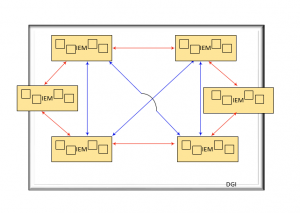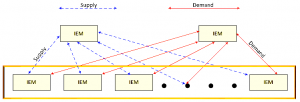IEM functions
Intelligent Energy Management is designed for providing optimized utilization of all renewable energy, minimum operating cost and voltage regulation. A step by step explanation of IEM:
| # | Step | Actors |
| 1 | A connection is established with the IEM and group management peer node using UUID (universally unique identifier). The generated UUID provides unique mapping for specific peer nodes. This activates the IEM | IEM-Broker |
| 2 | Manage individual connections by prioritization based message passing at run time. Prioritization helps communication in coordinated fashion as messages may contain sub messages. | CDispatcher |
| 3 | Power management is done in distributed fashion. Scheduling power migration by communication with individual SSTs. | SST-IEM |
| 4 | Power negotiation with SST for power balancing | SST-IEM |
However in case of failure, the group manager at step (3) collaborates with its peer IEM using the Invitation Algorithm of Garcia-Molina. The status of IEM is maintained by the group management and state collection within DGI. State collection is invoked when a consistent state is required.
Algorithm
An incremental cost consensus algorithm is implemented for distributed power migration in IEM. It minimizes the total cost by using local information to reach approximate consensus values for variants of distributed agreement. It uses concept of local marginal price (LMP). LMP provides a signal that is denominated in dollars per hour. For FREEDM we use distributed LMP or D-LMP’s.
Secondly, the control is central, so the information about loads, generator and output power among peers is known by the control. By using this algorithm the control calculates λ (incremental cost) based on the knowledge of power generation of each generator and arrive at a consensus.
Architecture Overview
IEM has both hardware and software components. The hardware component of each Intelligent Energy Management node is a Solid State transformer interface. It acts as an interface for various loads, DRER and DESD. Software component is the Distributed Grid Intelligence (DGI).The DGI is executed independently on all computers within IEM and IFM in the distributed hub. While some control is localized within each IEM and IFM, the DGI is needed to implement control functions that must be handled collectively by groups of IEMs and IFMs. The DGI has to balance the active power demands between IEM nodes. The following figure depicts this.
Heuristically, each IEM will broadcast a message containing a supply, neutral, or demand status. In the supply status, that particular IEM node has excess capability to supply active power to other nodes, either through an excess of renewable power or by discharging its energy storage. In the demand status, a particular IEM node requires additional power to meet its local demand. The neutral status is when neither a supply nor demand status exists. Two or more IEM nodes will pass messages negotiating load changes until all IEM nodes attain a neutral status. Active power is exchanged in units of power (1 kW for example) that is appropriate to the size of the distribution system.


